Professor ‘Lockdown’ Neil Ferguson has slammed a review that found lockdowns barely affected the Covid mortality rate.
The Imperial College London epidemiologist, whose modelling led the UK Government to impose the first lockdown, said the paper ‘does not significantly advance’ understandings of how effective the draconian measure is.
The review — by three economists from Johns Hopkins University in the US, Lund University in Sweden and the Danish think-tank the Center for Political Studies —ound lockdowns only reduced Covid mortality by 0.2 per cent in 2020.
But they found that the stay-at-home order (2.9 per cent), school closures (4.4 per cent) and business closures (10.6 per cent) were individually more effective.
Professor Ferguson said the report does not increase understanding of how different Covid curbs limit the spread of the virus.
He said the paper grouped together lockdowns that ‘varied dramatically between countries’, making it ‘problematic’ to determine how effective the policy was.
The report defines lockdowns as the ‘imposition of one or more mandatory non-pharmaceutical interventions’, Professor Ferguson noted.
‘By that definition, the UK has been in permanent lockdown since March 16 2021 and remains in lockdown — given it remains compulsory for people with diagnosed Covid to self-isolate for at least five days,’ he said.
Critics of the new lockdown report — which was published on Wednesday and has not been peer-reviewed — accused the working paper of being biased.
The meta-analysis was led by Steve Hanke, a founder of the Johns Hopkins School of Applied Economics, who has been an outspoken critic of economically-damaging restrictions throughout the pandemic. He previously described jab mandates as ‘fascist’.
One of its other authors — Professor Lars Jonung, from Lund — hails from Sweden, the only major country in Europe to go with a voluntary lockdown rather than a legally-binding one.
There are also questions about the methods used in the paper. Only 24 studies were included in the review and some were discarded for seemingly trivial reasons, which led to accusations the authors ‘cherry-picked’ studies.
But other experts said the review shows there is ‘no evidence that lockdowns did any good and accused the British media of ‘maintaining pandemic fear’ by failing to cover the report.
A new report led by a Johns Hopkins University economist found that overall, lockdowns reduced Covid mortality in the US and Europe — including Britain – by just 0.2 per cent. Looking at stay-at-home orders directly, they were slightly more effective at 2.9 per cent. closing nonessential shops was the most effective intervention, leading to a 10.6 per cent drop in virus fatalities. The report, which has not been peer-reviewed, said that this was probably due to shutting pubs and restaurants where alcohol is consumed. School closures were linked to a smaller 4.4 per cent decrease
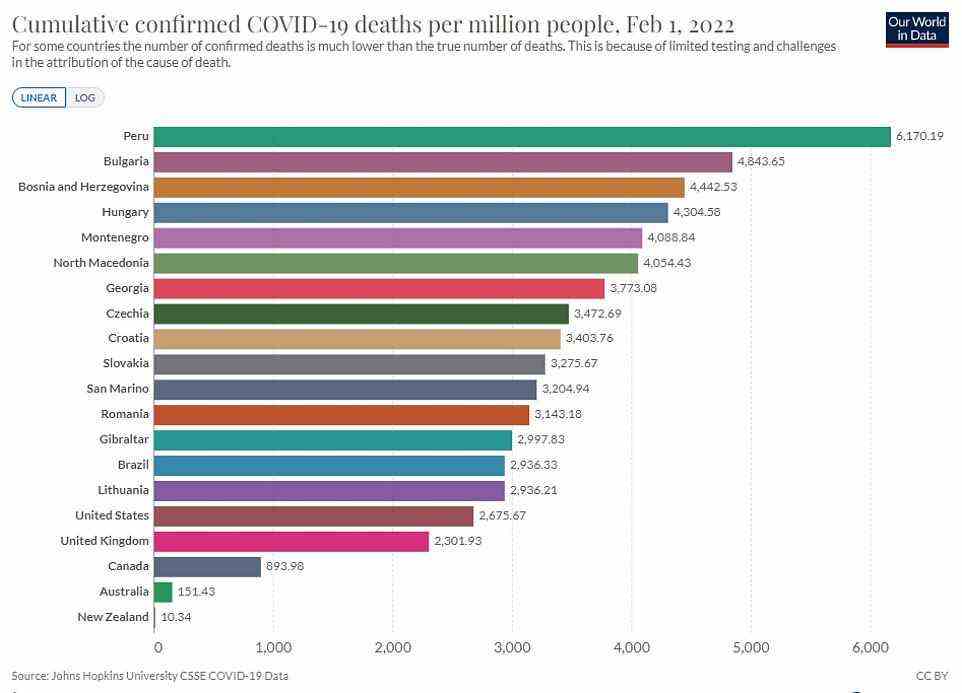
Above shows the top 10 countries with the highest Covid death rates, followed by the US, UK Canada, Australia and New Zealand for comparison
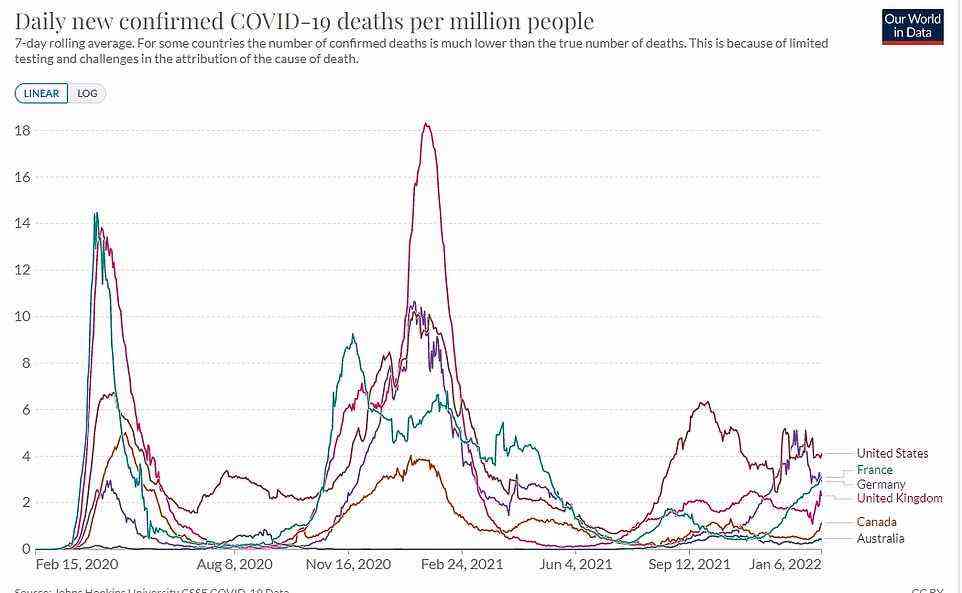
Daily Covid deaths in some of the West’s major economies: the United States, Britain, Canada, Australia, France and Germany
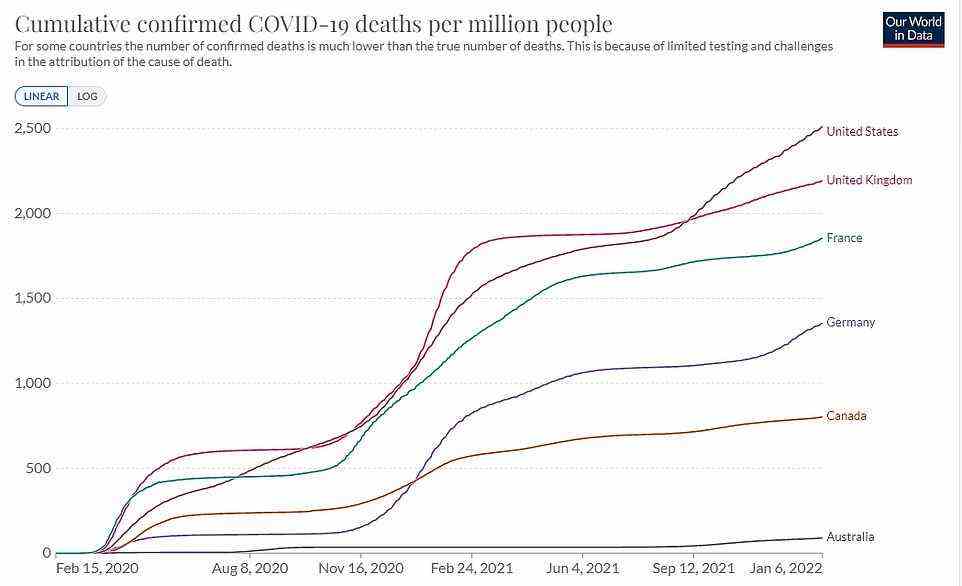
The UK and US have recorded some of the highest cumulative Covid death tolls in the world despite numerous lockdowns. Australia, which sealed off its borders for nearly two years, has started to see an uptick now but avoided major losses earlier in the pandemic

Professor Neil Ferguson, the Imperial College London epidemiologist whose modelling led the UK Government to impose the first lockdown, said the paper ‘does not significantly advance’ understandings of how effective the draconian measure is
Overall, the review found restrictions cut Covid fatalities by just 0.2 per cent. Border closures were one of the least effective measures, reducing the death toll by 0.1 per cent.
Ordering non-essential shops to close proved the most impactful rule, leading to 10.6 per cent fewer fatalities. School closures cut the death rate by just 4.4 per cent and asking people to stay at home reduced the fatality toll by 2.9 per cent.
And some curbs, such as those limiting how much time people spend outdoors, may have led to more deaths, the team warned.
Professor Ferguson, who was named in the study for predicting that lockdown would reduce Covid mortality by 98 per cent, questioned the economists’ methods for calculating that lockdowns have such little effect on the death rate.
The draconian restriction was generally imposed when infections, hospitalisations and deaths are trending upwards, he said.
The impact of Covid curbs on the virus fatality rates is delayed by a few weeks, so mortality rates immediately after lockdowns are introduced are ‘substantially higher than before’, Professor Ferguson said.
He added: ‘Disentangling the precise impact of individual NPIs [non-pharmaceutical interventions] remains extremely challenging.
‘The most socially and economically disruptive measures — closing all non-essential businesses, stay at home orders — were generally used in combination and as last resorts on top of longer-term measures such as mask wearing.
‘Analysis has been further complicated by the accumulation of immunity — from infection and vaccination — in populations together with the emergence of new Covid variants.
‘Distinguishing the relative effectiveness of mandates versus government recommendations — while clearly of political interest — is even more challenging, given the large between- (and even within-) country differences in population responses to both types of measures.’
To come to their findings, the US, Swedish and Danish whittled down 18,590 global studies on lockdown and lockdown restrictions to 117.
The criteria for the studies to be eligible were they must measure the effect of lockdown on mortality and use an ’empirical approach’ — meaning to use real-world data.
These were then boiled down to just 34 papers, with the others discarded for various reasons, including being duplicates or those which were written by student papers rather than fully qualified experts.
Reasons for excluding others were vague, however, with nine papers left out because they had ‘too few observations’ and nine more because they ‘only looked at timing’.
Crucially, the researchers also left out studies which looked at early lockdowns in countries which managed to suppress Covid and record extremely low death rates during the pandemic through incredibly strict lockdowns and border controls — such as China, Australia and New Zealand.
Noting this limitation, the authors write: ‘One objection to our conclusions may be that we do not look at the role of timing. If timing is very important, differences in timing may empirically overrule any differences in lockdowns.’
They add: ‘Including these studies will greatly overestimate the effect of lockdowns, and, hence, we chose not to include studies focusing on timing of lockdowns in our review.’
For reasons that are not made clear, only 24 of the 34 studies were actually carried through for the final analysis. The fact-checking website Truth Or Fiction criticised the latest paper for selecting papers that suited the authors’ own opinions.
Some experts criticised the paper for excluding studies that show drops in Covid deaths after lockdown measures were introduced, excluding countries that implemented early lockdowns and managed to suppress the death toll to very low levels, such as China, Australia and New Zealand.
But others tiday criticised news outlets for failing to report on the research.
MailOnline was just one of three major British media outlets to cover the findings this week, along with The Daily Telegraph and the online edition of the Daily Express.
It was not picked up by Sky News, the BBC or The Guardian, which have previously been accused of taking a pro-lockdown slant in their Covid coverage. But a number of other national newspapers also failed to cover the report, including The Times and The Sun.
An expert with links to the Government, who wished to remain anonymous, told MailOnline it is unsurprising that some publications avoided the story as they want to ‘maintain fear around the pandemic’.
Professor David Livermore, a microbiologist at the University of East Anglia, told MailOnline: ‘Almost all the major broadcasters, along with several papers have slavishly followed the ‘lockdowns work’ narrative throughout, generally without objective analysis.
‘So I’m disappointed, but unsurprised, that, once again, they are not headlining work — however well conducted — that comes to the contrary conclusion.’
MailOnline has approached Sky, the BBC and The Guardian for comment.
Professor Keith Willison, a chemical biologist at Imperial College London, told MailOnline: ‘I’m not surprised because those of us who argued for softer, voluntary quarantine regulations back in May 2020 were ignored.
‘The catastrophic economic and societal damage from the harsh lockdown regime is even harder to bear if it transpires that lockdown measures had minimal effects on reducing transmission of the virus in the UK too.
‘The Swedish policy was correct in that it allowed the public to moderate their behaviours while still keeping schools and communities functional. I bet Downing Street is now regretting passing new laws to regulate all our lives over the past two years.’
Professor Paul McKeigue, an expert in genetic epidemiology and statistical genetics, told MailOnline that the report’s findings were ‘too definitive’. But he agreed there was ‘no evidence that lockdowns did any good’.
He said lockdowns may have increased mortality, such as by sending students home to live with vulnerable parents and stopping elderly people from exercising.
The UK has been sent into lockdown three times throughout the pandemic. Some scientists unsuccessfully called for additional lockdowns during the Delta and Omicron waves.
However, Sweden’s strategy to contain the virus relied on the public voluntarily working from home and avoiding public transport, as well some light mandatory restrictions including table service in hospitality and limiting gatherings to 50 people.
Despite the more relaxed approach, the country has recorded less cumulative Covid deaths than the UK, 1,5791 fatalities per million people, compared to the UK’s 2,302 per million people.
But it has recorded more than all of its Scandinavian neighbours, which critics say is a sign it is not the perfect poster child for looser measures.
Professor Robert Dingwall, a sociologist and former Government Covid adviser, said the Swedish approach may not have worked well in all countries, but may have led to comparable hospitalisation and death rates in the UK ‘with much less collateral damage’.
Professor Dingwall added: ‘What is really troubling is the lack of interest by governments in properly evaluating these drastic social interventions, in comparison with the investments in research on vaccines and drugs.
‘We should not be debating attempts to make sense of poor-quality data but considering well-designed studies carried out alongside the lockdowns.
‘The public inquiry will need to ask why such work was not commissioned.’
Professor Dingwall noted that the new report was vulnerable to accusations of ‘cherry picking’ and is limited in that it brings together different restrictions imposed in different places at different times.
NHS Nightingale surge hubs set up to fight Omicron wave cost £10.6million and have treated just SEVEN patients
- NHS rapidly constructed eight overflow units at the height of current wave
- But the temporary structures have mostly stood empty in hospital car parks
- Health minister Edward Argar revealed they had a price tag of £10.6million
ByLuke Andrews Health Reporter For Mailonline
Advertisement
NHS Nightingale surge hubs set up to cope with Omicron cost £10.6million to build and have only treated seven patients, it was revealed today.
The NHS rapidly constructed eight overflow units at the height of the fourth wave in December as Boris Johnson put the health service on a ‘war footing’ against Covid.
They have been designed to hold up to 100 coronavirus patients each and have been assembled in the car parks of major hospitals in England
But the temporary structures have mostly stood empty, with some staff complaining they are taking up valuable parking spaces.
Health minister Edward Argar has revealed for the first time that the hubs cost £10,672,088 to build. And only one has actually seen any patients — at the Royal Preston Hospital in Lancashire, The Telegraph reports.
It had treated just seven patients by last Friday, meaning the NHS has spent the equivalent of £1.5million per patient.
Professor Karol Sikora, a cancer expert at Buckingham University, today blasted the units as an ‘abuse of taxpayers’ money’ and a ‘complete waste of time’.
He told MailOnline the money could be better spent in other areas that have missed out during the pandemic like cancer or tackling the record-breaking backlog.
‘What is needed in the NHS is to build up capacity and the staff,’ he said. ‘The key to healthcare is staff and trained staff.’

The above shows where England’s eight new ‘mini-Nightingales’ will be set up. These will aim to treat 100 Covid patients following a stay in intensive care, and will be on hospital sites to ensure they can be properly manned. Previous Nightingales could not get enough nurses
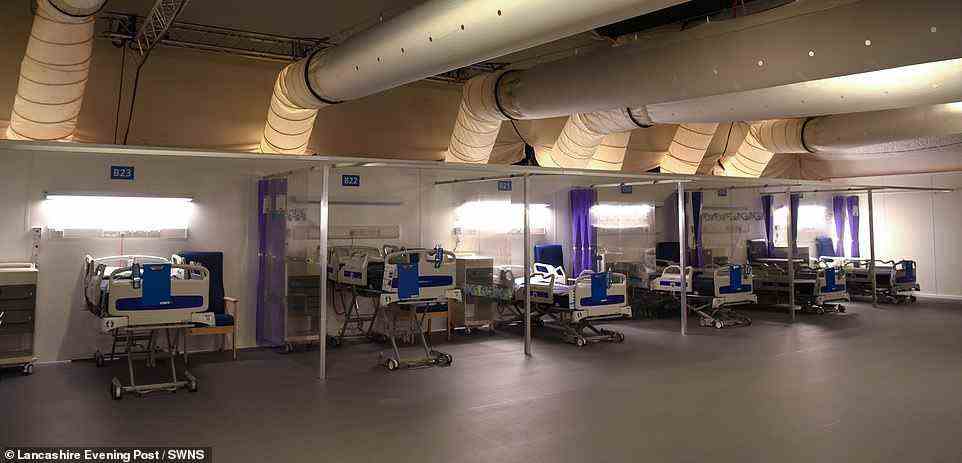
The Nightingale Surge Hub at Royal Preston hospital (pictured), one of eight makeshift wards at hospitals across England, has 100 beds for patients from across the North West
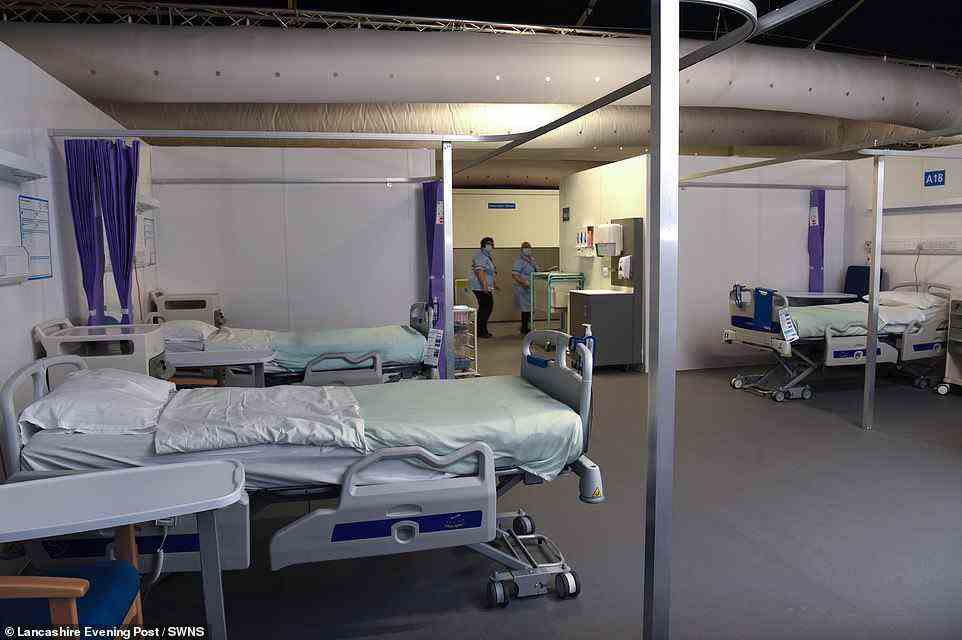
But the make shift unit at Royal Preston hospital (pictured) has only received seven patients to date. The wards are meant to take patients who still need care but are not seriously ill

Pictured above is the Nightingale hub at St James’s University hospital, Leeds. This unit has taken up valuable spaces in the car park, staff complain
Announcing the hubs in December, NHS England said they would be used if ‘the record number of Covid infections leads to a surge in admissions and outstrips existing capacity’.
Medical unions warned at the time they could swallow up staff and pull valuable resources from other parts of the health service.
The other hubs — in London, Leeds, Solihull, Leicester, Stevenage, Ashford and Bristol — have stood empty.
Local health bosses in London and Kent warn the hubs will likely never be used amid falling Covid admissions.
The Covid incident director for health services in the capital, Martin Machray, said last month there was ‘no plan at present’ to make use of their facility.
In response to a question on the cost of the surge hubs from Tory MP and former Cabinet Minister Damian Green, Mr Argar said ‘no decision has been made’ to decommission them yet.
He added: ‘This is being monitored daily by the National Health Service and the capacity will be stood down as and when the situation improves.’
The £10.6m piles on top of the £500million spent on England’s original Nightingale hospitals, that also stood empty for months before being mothballed.
Staff at St James’ hospital, Leeds, say their surge hub has left them with nowhere to park — and at risk of fines from parking attendants.
At Ashford hospital, a nearby athletics stadium has been turned into a makeshift staff car park, to make-up for the lost spaces.
Health chiefs at the hospital have expressed concerns that the structure ‘may adversely impact’ other services and never be used.
Daily Covid hospitalisations in England have fallen eight per cent in a week, according to the latest data as pressure on the NHS subsides.
Admissions stood at about 1,400 a day last week, down a quarter from the peak in early January and 62 per cent lower than the 3,700 hit at the height of last winter’s outbreak.
Covid patient numbers on hospital wards are also down a fifth from early January, while the number of patients on ventilator beds is also pointing downwards.
A total of 12,900 Covid patients on wards by January 30, the latest date available, far below the 28,000 at the same time last year.
Covid cases have flatlined in recent weeks, amid the return of schools and the emergence of a more transmissible version of Omicron. But there is no sign that this is likely to trigger an uptick in hospitalisations.
Individual hospital trusts can make their own decisions about the future of the temporary hospitals, NHS sources say.
A spokesman added: ‘As has been the case since December, the Nightingale hubs are there to be used if local health systems come under very intense pressure.’
MailOnline has asked the NHS how many of the surge hubs are actually up and running.




Professor Sikora slammed the spending on the Nightingale units today, telling MailOnline: ‘This is a complete abuse of taxpayers money.
‘You could commandeer the Hilton in Shepherd’s Bush (London) and convert it overnight if you wanted to but you have to have staff — that is what is lacking in the Nightingales.
‘It is political theatre to say we have built these Nightingales, and ‘isn’t it wonderful?”
Asked whether the money would have been better spent on cancer care, he said: ‘Of course I am going to say yes. It could also have gone on hip replacements people crippled.’
Danielle Boxall, media campaign manager at the Taxpayers’ Alliance, warned Britons ‘will not accept their money being wasted’ given the upcoming tax rise in April.
She told MailOnline: ‘Health bosses must ensure they are providing value for money.’
Criticising the new surge hubs earlier this month, Dr McGregor, from the British Medical Association’s Yorkshire Regional Council, told the BBC: ‘Each bed takes two to three staff to run it 24/7.
‘The workforce that can work is working and how we cover staffing of these units is going to be the most important part, because you’re going to be taking staff away from other pathways and other workload.
‘So we’re going to find ourselves falling further behind on our routine work.’
Meanwhile, the mild — but highly infectious — Omicron variant is causing more ‘incidental’ hospital cases.

